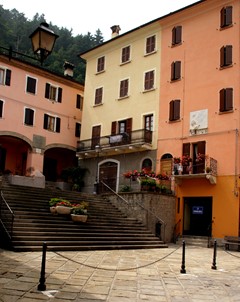Municipality of Castelnovo ne' Monti.
A wander through the Middle Ages
The territory of Catelnovo ne' Monti was inhabited in ancient times by successive populations, starting with the Ligurians, then the Etruscans, the Celts and finally the Romans, who built the first fortalice on the Pietra di Bismantova, the ruins of which were first discovered in the XIX century. After this it came under Byzantine and then Lombard rule and finally, around the year One Thousand became a fiefdom of the powerful Canossa family, who built the Castrum Novum, that is, the “New Castle” which gave its name to the village, as opposed to the Castrum Vetus which by this time had tumbled down onto the Pietra plateau. The castle was constructed sometime between 1062 and 1110 as defence against the Dallo, who had infiltrated the mountains near Reggio from the Garfagnana region, annexing the fiefdom of Bismantova for themselves. In the year 1111, the village fortress on the slopes of Mount Castello was given by Countess Matilda to the Benedictine monks of the Monastery of Sant'Apollonio.
In the following centuries, Castelnovo became the property of the Municipality of Reggio, seeing itself the subject of continual disputes between various feudal families including the Canossa, and eventually becoming a district administered by a Podestà of the Este family from 1492 to 1796. Of the ancient castle we can still see part of the keep and the defensive walls. The square tower, with its neatly squared-off sandstone ashlars, is reduced to a stump of masonry rising only a few metres. The historical nucleus of the village nestles in a natural depression surrounded by the slopes of Mounts Castello, Bagnolo and Forco across which stretch three pinewoods planted in the late nineteenth century.
The village we see now is of relatively recent origin, between the XIV and XV centuries. The buildings that surround Piazza Primo Maggio, the former piazza d'armi or parade ground, possess a certain historic and architectural significance. On the eastern side of the piazza sits a massive building whose characteristics recall a primitive tower house. Meanwhile perching on a hill at the edges of the built-up area is the ancient Pieve di Campiliola which received mention in 980 amongst the possessions of the diocese of Reggio as a church for commoners, and was considered an important landmark in the Apennine area.
Originally situated on the peak of the Pietra di Bismantova, only in the XIII century was it moved nearer the village, but we know virtually nothing of the ancient structure; what we see now dating to late seventeenth-century rebuilding work which transformed it from Romanesque to Baroque style. It was given its new name of Pieve di Castelnovo at the beginning of the eighteenth century. The church includes a large building for worship with an adjacent rectory and a walled courtyard inside which is a fine portico with an arcade. No visit to the territory around Castelnovo is complete without exploring the atmospheric medieval villages dotted across these mountains, drenched as they are in history and ancient legacies. Gombio, for example, is one of the most important villages with a medieval layout in the Reggio Apennines, characterized by several tower-houses and bare stone buildings of medieval origin. Roncroffio too is significant, with its late-medieval layout characterized by a fine tower house right in the centre of the village as well as some Renaissance buildings. Worth a look are the three ancient metati, communal chestnut driers, dating to the XVII and XVIII centuries.
Lying where the Rio Spirola meets the river Secchia, La Gatta is a settlement of great monumental value. Between the 1500 and 1600s the Gatti, an eminent local family, built their residences there as well as the church dedicated to Saint Anthony of Padua. The ancient Gatti palace forms part of a compact set of buildings, with an evident fortalice design, probably dating to the XVI century, while the most significant building from an architectural point of view is the newer Palazzo Nuovo dei Gatti, from the XVII century. Here were found forty or so graves with funeral trappings that indicated a Roman era necropolis.
With its moody setting and appealing architecture, the village of Maillo is located at the foot of the valley of the homonymous stream, amongst thick woods. From the VIII century onwards, mention is made of a castle which formed part of an extensive defensive system linked to other neighbouring castles and fortresses. Its ruins lie on the crown of a hill above the village.
